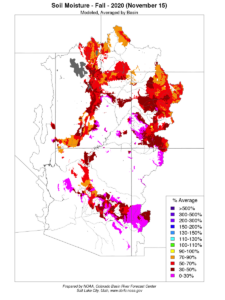Eric Kuhn points out some pretty striking numbers in the latest monthly Bureau of Reclamation Colorado River projections – a million-plus acre foot drop in expected flows on the river as we head into winter. Because of the river’s rules for coordinated operation of Lake Powell and Lake Mead, this translates into a big loss in Lake Mead next year – a 8 foot drop as compared to the numbers just a month ago.
Perhaps more importantly is the way this hydrology spills into 2022, with a clear chance that Mead could drop to elevation 1,060 by the end of the 2021-22 water year. The last time Mead was that low was April 1937, when it was first being filled.
The culprit seems to be low soil moisture heading into winter, which takes first cut at the water as snow melts come spring. It’s still early days in terms of winter forecasting, but with a dry summer the crappy soil moisture is already baked into the preliminary numbers Reclamation uses for its monthly “24-month study”.
We have lots of time between now and when we actually have authoritative numbers rather than just scary blog posts based on preliminary forecast numbers. But if the current numbers hold, the drop in Mead would push river system 2022 operations into the next tier of mandatory Lower Basin water use cuts under the river’s 2007 “Interim Guidelines” and supplemental Drought Contingency Plan.
Those mandatory cuts are not a huge deal at this point. (but see update below) Lower Colorado River Basin water users have pretty consistently been making voluntary cuts as big as the mandatory reductions in that next tier. This is a success story – Lower Basin water users have taken the steps over the last few years to prepare for this sort of bad hydrology. But it sure feels a lot better to be doing it voluntarily, ahead of a dropping Lake Mead, rather than to be seeing that bathtub ring grow.
Update: Several correspondents, in my inbox and on the Twitters, have suggested I should not be so sanguine about the ease with which Central Arizona water users will be able to absorb the 1,075 shortages, especially the Pinal County farmers who accepted big subsidies in 2004 in return for taking on the risks that they now face. See here for my views on this, and be sure to read the comments there for the smart people who disagree with my take.


Time for a backbone pipeline from the Pacfic to Nevada Arizona and New Mexico
No Bill, it is time to decide to live within our means. The Colorado River is “overallocated” and won’t produce as much water as we want, or as much as we currently plan.
Arizona’s loss will come entirely out of CAP. 512MAF (at an elevation of 1060′) is 1/3 of entire CAP allotment.
Udall & Overpeck predict that the river’s flow will decrease by about 20% in the next few decades. Brad Udall and Ken Seasholes (head CAP supply modeler) have both personally told me that their projections are mutually incompatible.
Really appreciate the “bathtub half full” optimism that the stakeholders will adapt to the bad hydrology and ongoing aridification!
Amen to that Mr. Blatchford!